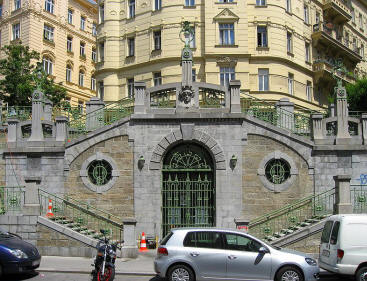Vienna Sightseeing in and Around Naschmarkt
Being in the hearty of the city there are many interesting destinations within a few minutes walk of Naschmarkt, or in the case of the Majolikahous, actually overlooking the market street. Visit some of these sights of the city, then stop again at the market for a refreshing drink or snack!

Majolikahaus - From within the Naschmarkt itself you can see Linke Wienzeile 38, 40, and 42 which are designed by Austrian Art Nouveau architect Otto Wagner. In particular number 40 which is also known as the Painted Buildings or Majolica Wienzeile after the type of ceramic tile used in its amazing decorations.
Fillgraderstiege - the fourth most beautiful staircase in Europe. Just two hundred meters north of the car park at the west end of the Naschmarkt Market. Built in 1905. Read more.
St. Charles's Church (Karlskirche) in the Karlsplatz at the north east end of the Nashmarkt. Completed in 1737 and renovated in 1980 it is a grand example of Roman Catholic Baroque Rococo architecture. It is flanked by the Musikverein and the Technical University of Vienna with contrasting stylesWienmuseum - Open every day except Monday from 10 to 6 for a fee of 8 euro this is the main art museum of the city in a very modern building.
Musikverein - Home of the home to the Vienna Philharmonic orchestra this is considered a concert hall with one of the best acoustics in the world.Vienna Künstlerhaus - A classical 19th century building which houses an exhibition centre for painting, sculpture, architecture and applied art as well as a cinema where films are screened for the Viennale film festival.
Kettenbrückengasse Station - A beautiful piece of period architecture, worth a visit even if you are not using the U-Bahn, which you should be!
Children's Museum - http://www.kindermuseum.at
Secessionsgebäude - This white exhibition hall various translated as "Secession Building" and "Secession Hall" in English is easily identified by its gold dome, it is located on the corner of the junction just beyond the north end of the market was built just three years before the end of the 19th century by Olbrich. Intended both as a place to show art, but also as a piece of art in it's own right. Seen also on the half Euro coin this structure is normally associated with the Succession Movement, a group of rebel artists who took Art Nouveau for themselves into new directions. One of the highlights of this style is the Beethoven Frieze which is on the front of the building.
Albertina Museum - Easily identified by the signature roof which flies out over the road in contrast the 18th century remainder of the building this important museum is visited as much for the building as for the world class collection of prints as well as many important originals such as the The Painter and The Buyer by Bruegel the Elder.
Schweizer Tor - Or "Swiss Gate" this is the finest and most colourful example of renaissance architecture in the city.
Strauss Monument - This iconic golden gilded statues of Johann Strauss is in the ever popular public Stadtpark near the Kursalon Wien building. Framed by a marble archway it is beside a beautiful lawn and with many flower beds nearby making this a great place for a photograph or a relaxing walk. In the same park also find the statue to another of Vienna's musical geniuses, Franz Schubert
Heeresgeschichtliches Museum - Housed in the old Arsenal complex completed in 1855 is this museum of Military history.
Graben - The most important shopping street right in the city centre, and running next to Stephanplatz and up to Kohlmarkt. Find here the major brand shops, as well as great Viennese eateries. read more
Stephansplatz - The official center of the city this major square is named for the St Stephen's Cathedral that dominates it. read more
Ringstrasse - The main circular route around the inner part of the city this wide boulevard stands where a 13th century city wall once was, and is the place to got for many of the most important historic sights of the city. read more
Museumsquartier - A collection of museums, both the MQ and the other museums which run from here which is just three blocks from Naschmarkt all the way to Michaelsplatz. read more.
Wiener Prater - This park beside the Danube is known for its amusement park. read more



